A lot of us have heard of a child theme in WordPress (WP) and other web solutions. We may or may not know exactly what that means. Some of us just need a little clarification. We’ll get into the nuts and bolts of child themes. But before we do, let’s look at the nuts and bolts of theme framework, the parent of all child themes. Let’s look at where understanding WordPress theme framework begins. Let’s find answers to some common questions.
Understanding WordPress Theme Framework Parent
Just the word framework implies the fundamental in theme creation. The framework starts with a code library. The library allows for theme development. When a theme framework gets created with use of the library, it acts as a parent theme. It also contains all the functionality. That means that while many child themes can be created from the parent, changes and updates solely in their functionality can be done just once. Done in the framework, it takes effect across all child themes. These changes and updates strengthen the primary, theme framework. They do not modify any child theme look and feel. It’s a win win. Knowing these facts alone helps out a lot in understanding WordPress theme framework.
Relying on that central code library solves a bushel of issues for the framework and child. Also, It makes life easy for both developers and users. Nobody ever has to go into each child theme of the parent to clear out a bug or push an updated function. At the same time, developers and users can customize and style a child theme to their heart’s content. They can do that without so much as a flicker of modification to the framework.
Understanding WordPress Theme Framework Types
WordPress theme framework types serve various solutions and needs. Some require no knowledge of code and have easy drag and drop features. What’s not to love? In Headway themes, everything can get created visually, free of coding. Now, the next step up in framework types is a pseudo drag and drop. Frameworks like Pagelines and Thesis let users drag and drop only pre-defined sections. Some knowledge of code comes into play. Understanding WordPress theme framework types wouldn’t be complete without including those that come chock full of options. Themify and most others you may hear of form that level. Both users and developers can really appreciate this type. Although, when it comes to seasoned developers, some of the best frameworks include Genesis by Studio Press.
Ready for some more WordPress theme answers? Get them from seasoned WP experts on the Prostyle Development Team. Ready to catch the WordPress wave for your next digital project? Plan on smooth sailing with Prostyle.
